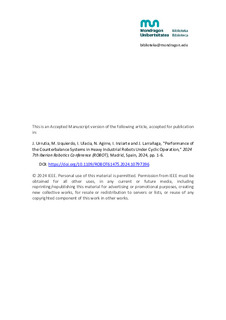Título
Performance of the counterbalance systems in heavy industrial robots under cyclic operationAutor-a
Fecha de publicación
2024Otras instituciones
Aldakin Automation S.L.Versión
PostprintTipo de documento
Contribución a congresoContribución a congresoIdioma
InglésDerechos
© 2024 IEEEAcceso
Acceso abiertoVersión de la editorial
https://doi.org/10.1109/ROBOT61475.2024.10797396Publicado en
Iberian robotics conference (Robot) 7. Madrid, 6-8 noviembre, 2024Editorial
IEEEPalabras clave
Counterbalance
Gravity compensator
Industrial robot
Temperature ... [+]
Gravity compensator
Industrial robot
Temperature ... [+]
Counterbalance
Gravity compensator
Industrial robot
Temperature
ODS 9 Industria, innovación e infraestructura
ODS 12 Producción y consumo responsables [-]
Gravity compensator
Industrial robot
Temperature
ODS 9 Industria, innovación e infraestructura
ODS 12 Producción y consumo responsables [-]
Resumen
Industrial robot accuracy is limited in applications such as machining processes, mainly due to the relatively low stiffness of the joints. Deviations are caused by the weight of the links, external f ... [+]
Industrial robot accuracy is limited in applications such as machining processes, mainly due to the relatively low stiffness of the joints. Deviations are caused by the weight of the links, external forces, inertias and the effects of the counterbalance system (CBS). The latter are hydropneumatic cylinders used to decrease motor torque and support the heaviest links. The counterbalance system influences joint torque and subsequently affects calculated deviations, making its behavior essential in robot positioning error models. While position-dependent static isothermal counterbalance models are presented in the literature, the effects of repetitive use and subsequent temperature increases on the counterbalance systems have not been thoroughly analyzed. This study examines a counterbalance system, focusing on its behavior under cyclic performance and the subsequent temperature increase. Measurements indicate that the temperature increases with the cycles, causing a rise in pressure. The temperature rise does not remain constant with cycles, instead, it gradually decreases until it stabilizes. Additionally, it is observed that increasing the rotational speed of joint 2 also increases the temperature gain of the counterbalance system. This variation is been seen to affect the final position of the robot's tip through the modification of the gearbox torque of the joint 2. [-]
Colecciones
- Congresos - Ingeniería [436]





















